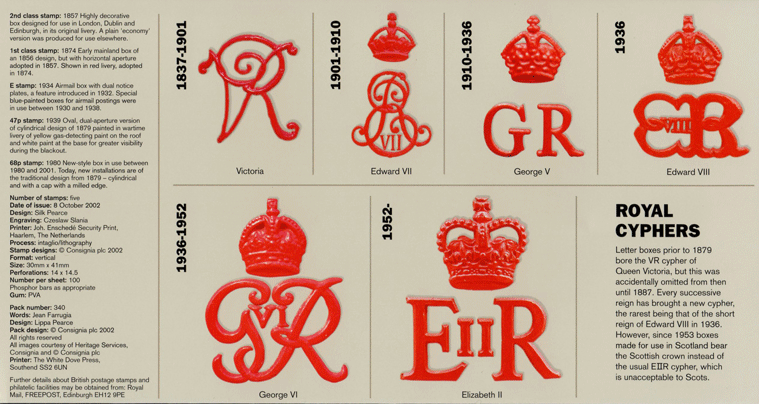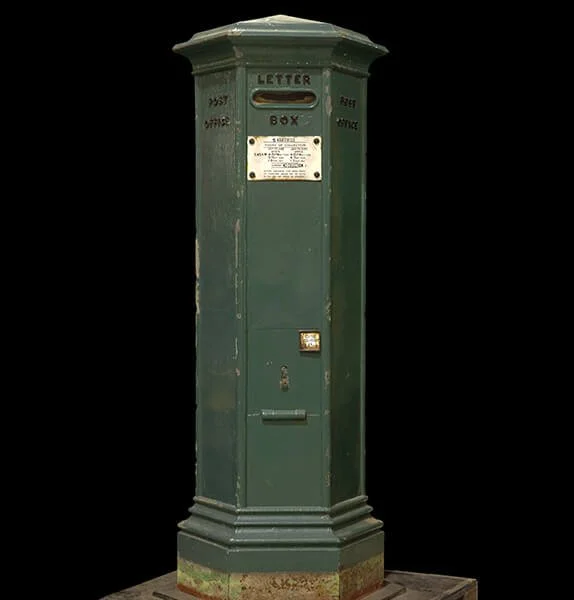The Humble British & Irish Post-box.
The unassuming post-box in Britain and Ireland is an item that is used by millions of people daily, there is, however, much more to this iconic symbol of Britishness that passes most people by, Our meek post-box first appeared on a trial basis in the Channel Islands in 1852 (Jersey) and later the trial was extended in (Guernsey) 1853 (Unfortunately none of the original cast-iron pillar boxes from Jersey survive, only the 1853 Guernsey example endured the test of time ) In the latter part of 1853 boxes began to appear on the British mainland and it was the responsibility of local surveyors to carry out the design and installation, leading to a mish-mash of non-uniformed design up and down the country.
The original Jersey (1852) box was RED, but later in 1853 on Guernsey it was GREEN, and until 1859 local authorities could decide on practically any colour scheme or shade that they wanted, However, in 1859 the standardisation on colour was in fact GREEN. The early green boxes were unobtrusive and inoffensive, so much so that the public started to complain as they had difficulty finding them and a return to red was ordered in 1874. It took over 10 years for the transition of colour to take place. The post box size and shape varied from hexagonal, square, and round. They came as free-standing units, wall mounted rectangles and in smaller communities, they were attached to the side of existing lampposts
The oldest working pillar box in the UK can be found at Barnes Cross, near Sherborne in Dorset. The octagonal box was manufactured by John M Butt & Company of Gloucester in 1853. In contrast, 2022 has seen over 50 new post-boxes installed across the UK, spanning an age gap of 169 years from eldest to youngest.
Originally post-boxes did not contain the Monarchs initials or crest on them, as this was a later design addition. The first letters to be used were V.R (Victoria Regina) Commonly known now as a royal cypher, there are currently 6 that appear on British and Irish streets. Some rarer than others, Edward VIII was only King for 325 days, making the ERVIII boxes very rare indeed. The letter R for Queens means Regina and for Kings Rex. This design feature has become a valuable source to historians and architects alike, it can date the history of an area, even if there has been significant re-development as often the buildings will change but the streets and post-boxes remain untarnished. Take the Springburn area of Glasgow, this area was heavily redeveloped in the post-war era, leaving practically no trace of its Victorian powerhouse past, but in amongst a 1960s block housing and high-rise complex sits a pillar-box with the inscription VR, giving a nod to the history of the area.
In 1930 BLUE airmail boxes were commissioned, although their lives were shortlived. Later having their airmail topper removed, the majority were painted red, becoming a standard-issue box. Rare blue boxes do still exist, and an example can still be found in Windsor, England, on the junction between Windsor High Street and St Albans Street.
There are thousands of pillar boxes across the UK and the best way to date them is to look at the Monarch’s cypher, when the Monarch changes the current boxes will not be replaced, just added to. In Scotland, you will not see ERII on many, if any post boxes, this is because of the political climate and the diverse opinion amongst some of the Scottish community that may not recognise Queen Elizabeth II as a ruler of Scotland. Early ERII boxes have been vandalised and even blown up in the postwar years. It is a similar story in Ireland; there are no ERII signatures in the republic. Post-boxes in Ireland remain GREEN.
The latest colour change was during the London 2012 Olympics; boxes were painted gold in local areas if an athlete from that city, town or village won a gold medal for Team GB. A gold post box has become an enormous sense of pride in local communities.
The impending:
It is currently unclear what royal name Prince Charles will take when he becomes King, the new Royal Cypher could read CRIII or, like many Monarchs before him, he may choose one of his middle names to become King George VII, King Philip I, or King Arthur I. So, we will have to see what the future brings for our humble little postbox.
Did you know: Royal Mail is One of the oldest organisations in the world, The Royal Mail Group can trace its origins back over 500 years to 1516
1840: Back to (The Penny) Black:
The world’s first adhesive postal stamp, the Penny Black, was launched in 1840, in a time before the first recognisable UK post-boxes existed. Queen Victoria appears on the stamp and sixty-eight million were used in the first year alone. The introduction of the Penny Post led to a great increase in the popularity of mail, and it was then that the demand for a new way of sending letters was reconfigured, leading to the overhaul and creation of the pillar box in 1852.
I would like to dedicate this article to Dan Issitt (real-life ghost stories podcast co-host) a friend, who unexpectedly died in 2021. The topic of post-boxes was always a firm favourite of ours. I think of Dan every time I see one. I now have a post-box shaped hole in my life. He is missed.
Ollie Green 2022.
Instagram @the.history.emporium.plus


